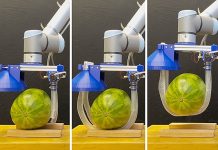
Researchers at Cornell University have created incredibly small robots, less than 1 millimeter in size, that can change their shape and crawl when given a jolt of electricity.
These tiny robots, which start as flat sheets and morph into 3D shapes, could lead to a new generation of highly flexible and adaptable machines.
Their design is based on kirigami, a method similar to origami, but with cuts in the material that allow it to fold, stretch, and move in ways that traditional robots cannot.
The study, titled “Electronically Configurable Microscopic Metasheet Robots,” was published in Nature Materials on September 11. Postdoctoral researchers Qingkun Liu and Wei Wang are the co-lead authors of the paper, and the project was led by Itai Cohen, a professor of physics.
Cohen’s lab has worked on microrobotic systems before, including robots that can move their limbs, pump water, and even walk autonomously.
But this new project is unique because it focuses on creating robots that can completely change their shape, much like certain living organisms do in nature.
Liu explained that most robots, once built, can move their parts, but their overall shape stays the same. The new “metasheet” robots are different.
The “meta” part of the name refers to metamaterials—materials made up of many tiny building blocks that work together to create specific mechanical behaviors.
In this case, the robots are made from hexagonal sheets, composed of around 100 tiny panels made of silicon dioxide, which are connected by more than 200 extremely thin hinges.
These hinges are only about 10 nanometers thick, thinner than a human hair, and can bend and fold when activated by an electrical charge.
When electricity flows through external wires, it triggers the hinges to form mountain and valley folds, which allow the panels to rotate and expand. The robots can change their shape by expanding and contracting by up to 40%.
This movement lets the robots fold into different 3D shapes and even wrap themselves around objects, then return to their original flat form. This flexibility and adaptability make them different from traditional rigid robots.
The development of these robots was inspired by living organisms that can change their shape to adapt to their surroundings. The goal was to create a robot that could not only move its limbs but also alter its entire structure.
These metasheet robots are composed of numerous tiny units that all work together to give the material its unique mechanical properties.
The team at Cornell is already looking ahead to the future of this technology. They are planning to combine these flexible mechanical structures with electronic controllers, creating what they call “elastronic” materials.
These materials would be capable of reacting to stimuli in ways that are far beyond what we see in nature.
The applications for such technology could be wide-ranging, from tiny medical devices that could be used inside the body, to materials that can react to impacts almost instantly, offering protection or changing shape in response.
Professor Cohen envisions even more possibilities for this technology. He imagines materials that, when touched or “prodded,” could move away on their own or push back with more force than they received.
The robots’ ability to harvest energy from light could make them responsive to their environment in ways never seen before, leading to the creation of materials that act intelligently, governed by new physical principles beyond those found in the natural world.
These active metamaterials—what Cohen refers to as elastronic materials—could represent a new form of “intelligent matter.”
These materials could interact with their surroundings in sophisticated ways, offering potential applications in areas such as reconfigurable micromachines, biomedical devices, and materials that can respond at nearly the speed of light.
In summary, the development of these microscopic robots is a major step forward in the field of robotics.
Their ability to change shape, move, and adapt to their environment opens up a wide range of possibilities for future technologies. Whether it’s in medicine, engineering, or everyday life, these tiny robots could have a big impact.
The research findings can be found in Nature Materials.
Copyright © 2024 Knowridge Science Report. All rights reserved.



